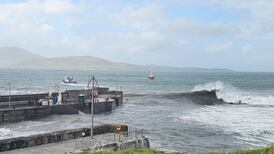That award to our football fans on Thursday was not of course the first time Irish people have collected a medal in Paris, or even in the seventh arrondissement.
It was more of a novelty for the Northern fans, I suppose. But a short walk from the Champs de Mars, where this week’s presentation took place, is a venue in which, over the decades, countless thousands of Irish have been involved in medal collection ceremonies.
I refer to the Rue du Bac, site of the convent wherein, on July 18th, 1830, a young woman named Catherine Labouré claimed the first in a series of visitations from the Virgin Mary.
The vision warned of evil times ahead, and suggested the striking of a medal to sustain the faithful. Even the specifications were provided. So, after some scepticism, what became known as the “Miraculous Medal” was minted, and was soon being turned out in its millions.
When those of us of a certain age were children, we were never considered fully dressed without the medal pinned somewhere (usually to a vest, which also de rigueur back then). And you could get one almost anywhere. But the Chapelle de la Médaille Miraculeuse on Rue du Bac was the place to go.
In the cult’s heyday, it must have rivalled Lourdes. Indeed, when the Lourdes pilgrimage was still an overland journey, a detour via the Paris convent was normal. I recall Seamus Heaney, somewhere, remembering such a trip.
One of the reasons Catherine Labouré was able to assuage initial doubts about her claims, apparently, was that the first vision included mention of another imminent revolution in Paris.
You did not have to be much of a prophet in July 1830, probably, to sense trouble ahead. The king (Charles X) had just passed several unconstitutional laws. Barricades were going up already. But sure enough, nine days after the apparition, the July Revolution swept Charles into exile, ending the Bourbons’ reign, and installing the more liberal Orléanist, Louis Philippe.
The latter became known as the “Citizen King”, being elected to rule “the French”, not “France”, although in due course his “July Monarchy” would also give way to revolution (the 1848 one), after which neither France nor the French bothered with kings again.
In the meantime, Paris’s continuing troubles included a cholera epidemic in 1832, which killed 20,000. This coincided with delayed production of the medal, so that the devout poor took to wearing it as protection from the disease. A number of presumed miracles resulted, securing the medal’s reputation.
Irish people still visit the Rue du Bac in substantial numbers, although now it’s not always for the chapel. The street’s secular attractions include that great materialist cathedral, Le Bon Marché, the first (and probably most beautiful) department store in Paris, whose food hall, La Grande Épicerie, is a place of worship for gourmets.
On my visit there, I was particularly impressed by the egg section, where an advisory note divides the produce into different vintages, with a range of suggested uses.
The freshest eggs, for example, are recommended for poaching, mayonnaise, or chocolate mousse. From 10 to 14 days, however, scrambling is more advised.
But if the egg is 15 to 28 days old, basically, you’re looking at hard-boiling, omelettes, or a quiche.
In keeping with its cathedral status, the store even has a large stained-glass window. Or so I thought at first glance. On closer inspection, it turned out to be the bottled water display, where the multicoloured treasures include one with a price tag of €50. This suggests that, if we didn’t know it already, the 1830 revolution still has work to do.
But speaking of July monarchies, I have been asked to mention the one that was proclaimed in south Monaghan 80 years ago, which will be commemorated again this weekend.
As readers may recall, the original catalyst was a dance in “Billy Brennan’s Barn”, circa 1935, failure to gain admittance to which provoked the dejected poet Patrick Kavanagh to declare himself “king and government and nation” of an adjacent one-mile stretch of deserted road.
He further asserted authority over the said road’s “banks and stones and every blooming thing”, but soon renounced the claim, abdicated, and spent the rest of his life in exile.
Happily, the poem, if not the monarchy, is still widely recognised. Indeed it is now the excuse for a mini-festival in his native village every summer. The latest instalment of “Inniskeen Road July Evening” starts this afternoon (patrickavanaghcountry.com).











